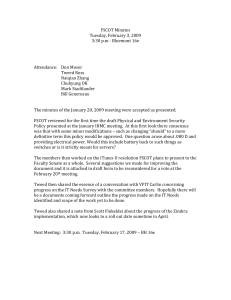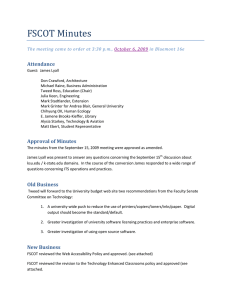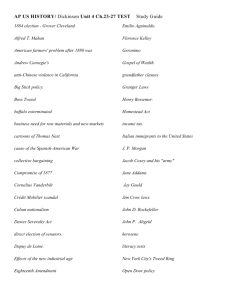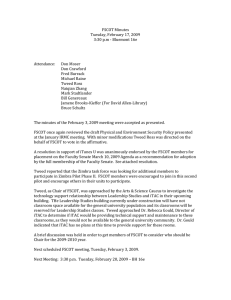timelines - Murwillumbah Historical Society
advertisement
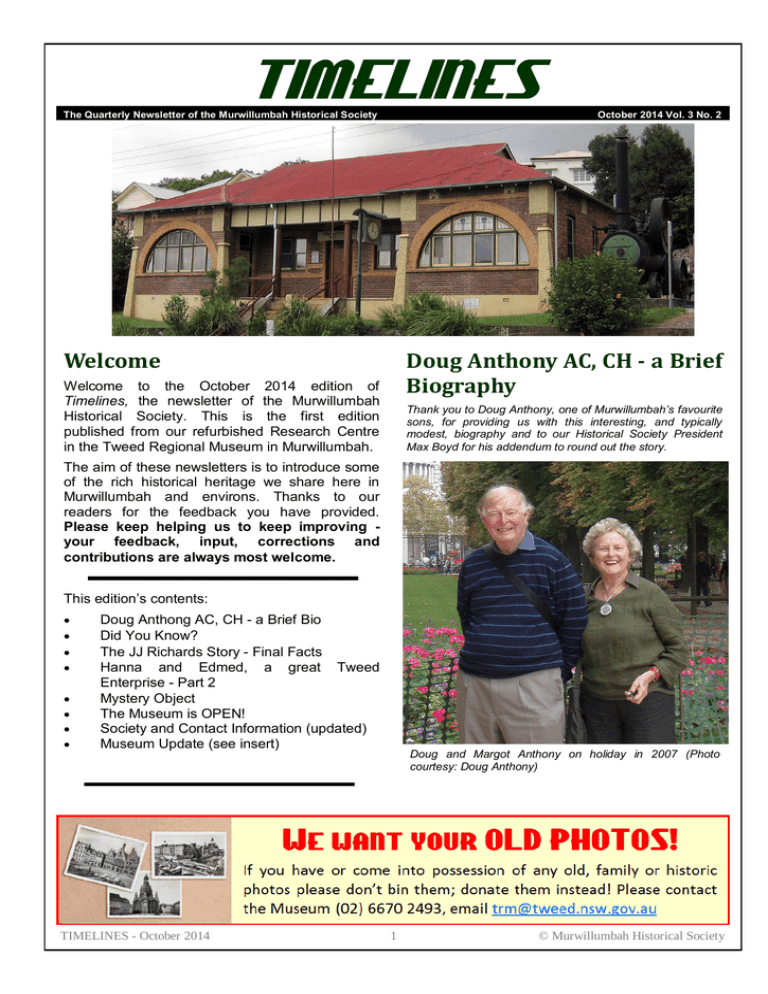
TIMELINES The Quarterly Newsletter of the Murwillumbah Historical Society Welcome October 2014 Vol. 3 No. 2 Doug Anthony AC, CH - a Brief Biography Welcome to the October 2014 edition of Timelines, the newsletter of the Murwillumbah Historical Society. This is the first edition published from our refurbished Research Centre in the Tweed Regional Museum in Murwillumbah. Thank you to Doug Anthony, one of Murwillumbah’s favourite sons, for providing us with this interesting, and typically modest, biography and to our Historical Society President Max Boyd for his addendum to round out the story. The aim of these newsletters is to introduce some of the rich historical heritage we share here in Murwillumbah and environs. Thanks to our readers for the feedback you have provided. Please keep helping us to keep improving your feedback, input, corrections and contributions are always most welcome. This edition’s contents: Doug Anthong AC, CH - a Brief Bio Did You Know? The JJ Richards Story - Final Facts Hanna and Edmed, a great Tweed Enterprise - Part 2 Mystery Object The Museum is OPEN! Society and Contact Information (updated) Museum Update (see insert) TIMELINES - October 2014 Doug and Margot Anthony on holiday in 2007 (Photo courtesy: Doug Anthony) 1 © Murwillumbah Historical Society I am very lucky to have been born in Murwillumbah and brought up on the Tweed. As one who has been fortunate enough to travel and seen much of the world I can’t think of a better place to live. member for the Federal seat of Richmond in 1937, became a member of the Federal War Cabinet in 1940-1941, and again a Minister in Menzies’ government from 1949-1956. In my early farming years I was not a politically active person but there was a considerable pressure for me to nominate as a candidate for the Country Party, in the seat of Richmond, after my father died. I stood for election and won the seat, which I held for 27 years until my retirement in 1984. During that time I held a number of ministerial positions serving with the Menzies, Holt, Gorton, McMahon and Fraser governments. I became Australia’s longest serving Deputy Prime Minister. My family lived in Canberra during my ministerial years and would return to the farm at Sunnymeadows, Murwillumbah, in school holidays. Because of my ministerial responsibilities it was essential to have a home in Canberra. As Minister of the Interior, those responsibilities also included the development and the administration of Canberra. Later my overseas obligations had me travelling the world. Had we not lived in Canberra I would not have seen much of my family given the public life I was leading. The Anthony family property just outside Murwillumbah (Photo courtesy: Doug Anthony) My father, Hubert Lawrence (Tony) Anthony, was born in Warren in western New South Wales and joined the Post Office at 14. He enlisted in the Second Light Horse division at 17 and was at the landing of Gallipoli but after two days the Light Horse division was returned to Egypt. He was sent back to Gallipoli and three months later was wounded and repatriated to England for medical attention. Later he was returned to Australia where he was medically discharged. In 1919 he was allotted a soldier settlement block of land at Banora Point. He married a Ballina girl, Jessie Stirling, and they settled on a farm where he grew bananas. The bananas were wiped out with bunchy top so they then moved to Murwillumbah where I was born. As a young boy growing up in Murwillumbah my life was free and full of fun: canoeing, fishing, sliding down the hills, bicycle riding, shooting, collecting birds’ eggs with my school mates. Life was never dull. The only rule was to be home before dark. After primary and high schools, boarding school and later studying at Gatton Agricultural College, I managed my father’s property at Bangalow. We had a dairy and grew bananas, pineapples and small crops, and with A.B. Cottie built a pineapple canning factory at Ballina. In 1957 I married Margot Budd who had been at Murwillumbah Primary School at the same time that I was there. We had three children over the next four years. Doug Anthony at his recent SCU award ceremony (Photo courtesy: Doug Anthony) My father died in 1957. He had been elected the TIMELINES– October 2014 2 © Murwillumbah Historical Society I retired back to the farm after my political career when we took up permanent residence in Murwillumbah. My wife, Margot, and I could then establish our garden, our farm and the house I had started to build 27 years earlier but had never finished. For all of us these were very happy times. In latter years I have had directorships with companies and some jobs for the government. Undoubtedly, this remarkable complex owes so much of its fame to the fabulous location on which it has been built and the superlative landscape and views that can be enjoyed from its balconies and many outlooks in different parts around the building, including the café. Living back on the Tweed our attention was drawn to the flourishing cultural activities in the area. We were impressed to see the local community coming forward and giving support to the museum and local arts and crafts. Through the enthusiasm of the historical societies our museums have grown and it’s marvellous to see that we now have a very modern, up-to-date and impressive museum in Murwillumbah. In the art world bringing various people together was important. The development of the art gallery began with the support of Doug Moran and his national art competition. This started the momentum to give the Tweed its first art gallery, opening in 1988. Margot and I have been closely associated with the development of the regional gallery from that time and today we have an outstanding facility of national significance. One of the lovely views at the Tweed Regional Gallery (Photo courtesy: Doug Anthony) All of the several pieces of land that the Regional Gallery and Margaret Olley Art now occupies were most generously beginning in 1995, to Tweed Shire Council purpose by Doug and Margot. I have been very lucky to have had such an interesting, exciting and fulfilling life with a wonderful partner, Margot. And as I have often said to my friends, it would take a team of horses to drag me away from here. The Tweed Regional Gallery and Margaret Olley Art Centre will stand as a lasting memorial to two of the Tweed’s finest citizens and patrons of the arts. ADDENDUM - written by Max Boyd AM, President of the Murwillumbah Historical Society. Honours and Awards Doug Anthony is a Privy Councillor and has been awarded a Companion of the Order of Australia (AC); a Companion of Honour (CH); honorary doctorate degrees at Wellington University, New Zealand, Sydney University and Southern Cross University, Lismore; and Gold Medals from Gatton College, Canberra City and a New Zealand Commemoration Medal. No written word covering the history of Doug and Margot Anthony could possibly be complete without reference being made to the profound contributions both have made to the cultural growth of Murwillumbah and the Tweed. They have played significant leading roles in the 1986 commencement of the Doug Moran National Portrait Prize and the establishment of the Tweed’s first art gallery opened by Doug in 1988. Most importantly has been their continuous involvement since then, to the present day, with the Tweed Regional Gallery and Margaret Olley Art Centre. Did You Know? This series of stories, selected and edited by Max Boyd, highlights the famous people, clubs, institutions and more who have had a connection with our district. This latest instalment features Sir Harry Budd. This magnificent art complex has become a stunningly successful destination for many thousands of visitors who have been drawn to it since the first stage was opened on 1st April 2004; the second in September 2006 and the “piece de resistance” - the Margaret Olley Art Centre as the third stage on 8th March 2014. TIMELINES - October 2014 Tweed Centre gifted, for this Sir Harry Vincent Budd was born in Murwillumbah on 18 February 1900, a son of Arthur Eames Budd a member of the New South Wales Legislative Assembly. He married Colina McDonald on 26 January 1930 and they had two sons and two 3 © Murwillumbah Historical Society daughters. References: Before entering political life he had a notable background in newspapers and journalism. He first began reporting for the Tweed Daily, acting as its Editor from 1921 until 1923, when he commenced work with the Daily Telegraph in Sydney. He subsequently became the Editor of The Land from 1931 to 1971, a leading agricultural newspaper that still continues to deal with rural issues and concerns. 1. 2. Following in his father’s footsteps, he joined the Country Party and entered the Legislative Council in 1946. He quickly became the Country Party’s leader in the Upper House. He used his political prominence to champion the of the Hon. Sir Harry Vincent Budd (Photo interests courtesy: Parliament of NSW ) rural community throughout NSW. He was an outspoken advocate of decentralised commodity pricing and he favoured a system of efficiently organised industry marketing to promote rural produce. He was made a Knight Bachelor by the Queen in 1970 for his services to the State and primary industry. The JJ Richards Story - Final Facts Thanks to Idwall Richards, son of JJ Richards, for providing these interesting brief statistics on the broad scope of the company’s current operations. Hanna and Edmed, a Great Tweed Enterprise - Part 2 Our thanks to Ross Johnson, the coordinator of this interesting history, for permission to publish the story on another iconic Tweed enterprise, Hanna and Edmed. This is Part 2 of the story. [The story of St Paul’s Kunghur continues….] The church still stands as a private residence. From 1966 until his retirement in 1978 he was President of the Legislative Council, a position that he filled with great distinction. His other interests included: Vice-President of Medical Benefits Fund of Australia from 1950, Director of Country Television Services Ltd between 1958 and 1976, Councillor Sydney Church of England Girls Grammar School, President of the Institute of Journalists from 1953 till 1955, and Australian National Advisory Committee for the United Nations Educational Scientific and Cultural Organisation (UNESCO) Bangkok 1964. Opening of St Paul’s Church Kunghur 1933 (Photo courtesy: Hanna Family) He was a keen student of languages and spoke French fluently. He had a great knowledge and love of classical music. He died on 8 March 1979 at Mosman in Sydney. TIMELINES– October 2014 Parliament of NSW website item https:// www.parliament.nsw.gov.au/Prod/Parlment/ members.nsf/ec78138918334ce3ca256ea200077f5d/ de01efd9e72b5c08ca256cbc0006b6e1? OpenDocument Legislative Council document “Death of Hon. Sir Harry Vincent Budd https://www.parliament.nsw.gov.au/Prod/ parlment/hanstrans.nsf/V3ByKey/LC19790320/ $file/461LC025.PDF Another building of which they were proud was the beautiful timber Church Rectory at Uki. The building was destroyed by fire on 21st May, 1968 and the adjoining church saved by a ‘bucket brigade’. 4 © Murwillumbah Historical Society Hanna Pty Ltd. With relief from post-war trading, the construction business grew rapidly and the Tweed, in particular Murwillumbah, was experiencing boom conditions. George’s talents became increasingly recognised by community leaders and his work expanded from housing into major commercial buildings. With completion of the new family home facing Ewing Street, the temporary family home was moved to Bray Park and used as a work shed. With the supply of materials not always reliable, he also used the depot as a storage area for building materials he stockpiled whenever available. This enabled George to be one of the first in the district to issue firm contract prices. Holy Trinity Church & Rectory Uki (Photo courtesy: Hanna Family) The Hanna’s both enlisted in World War II but Bob was denied acceptance due to medical problems. At this stage, with George accepted into the Army, Bob returned to Sydney where he continued his building career, until retirement, as a supervisor with the Public Works Department, Bridge Street, Sydney. The disastrous floods of 1954 and 1956 put an end to this site and much of his equipment and materials were destroyed. George then decided to acquire a large, flood-free site in Byangum Road, Murwillumbah, which was to become headquarters for the growing business. George’s enlistment took place on 5th February 1942. He was a sapper with the 2nd Australian Transport Company and was posted to Alice Springs where his unit was involved with military hospital construction at Howard Springs. The unit also saw active service in New Guinea where George believed rations were George Hanna (Photo courtesy: better than in Darwin! George Hanna ~Builder~ 1949 (Photo courtesy: Hanna Family) Hanna Family) Upon return to the Tweed after the war, George commenced building work as a sole trader. Working initially from the temporary family home in Ewing Street, backing onto Bent Street, the business soon expanded to the extent where he established the company G. George’s respect and knowledge of the building industry led him to form many firm relationships with subsidiary trades in the town. These included STEVEN’S JOINERY, from its then factory in Church Lane and R DUNN and SONS’ STONEMASONS, a then neighbouring business in Bray Park still operating from the same premises today. George’s ability to design and construct buildings was extraordinary. One of his greatest challenges was in 1952 when charged with the responsibility of designing and constructing a large Parish Hall for the Anglican Church. The site was hazardous for any designer as it was a swamp that had been filled with a variety of materials including old car bodies, which he knew would rust and subside. (Removal of such fill with today’s machinery would not be a problem!) He produced the drawings and Returned army mates from the Uki region: L-R John French, Bill Edmed, Cliff Venn, George Hanna (Photo courtesy: Hanna Family) TIMELINES - October 2014 5 © Murwillumbah Historical Society constructed the building on a raft slab to allow the building to ‘float’ on the fill. The building is still ‘floating’ today as the main building of the Sathya Saya School, free from structural cracks, although the 1954 flood water reached window sill level on the upper floor! Tweed Shire Council Offices in Main St RSL Club, Queen St A building which gave George great delight and recognition was the construction of the Anglican Church in Byangum Road, Murwillumbah, designed by leading Brisbane architects, Conrad and Gargett. All Saints Anglican Church, Murwillumbah (Photo courtesy: Hanna Family) George Hanna’s family in 1951: L-R George Jnr., Del, Jeanette, Mabel (Photo courtesy: Hanna Family) Building commenced in February 1960 and was completed on 1st November 1960. Thirty men worked on the building and it was completed at a cost of $111 000. The building contains the last major teak and cedar supplies from the Tweed. In 1957~58, George won the contract to build an extensive chain of new hotel-motels for the ASTOR GROUP. It was a fast and furious era of construction on the Tweed and with work away around Southern Queensland at Advancetown and Beaudesert, the complex at Byangum Road saw ever increasing expansion. It also included the ‘ROD and REEL’ hotel still attracting customers at Woodburn. This meant major expansion, and for the first time work away from the Tweed, perhaps a taste of major things to happen in In 1959, George Hanna merged with his brother – in- law, Bill Edmed, who had been trading as W.C. Edmed Pty. This company had also constructed many homes and commercial buildings in the district and several holiday apartments on the Gold Coast, including Greenmount Place at Coolangatta, and Oceania at Kirra. With the merger of the two companies, expansion proceeded at an exceptional pace. The headquarters complex at 194 Byangum Road, Murwillumbah was expanded to house: the future. Other buildings constructed in the era included: The Murwillumbah Masonic Centre The Court House Hotel Budd’s Store Raward’s Store Sunrise Motors (Partridge and Walker) The Ocean View Motel (still standing opposite Twin Towns Services Club) Red Cross Centre in Knox Park CWA Building in Queen Street TIMELINES– October 2014 6 The Company, Hanna and Edmed Pty Ltd’s, Head Office. Building Company Workshops. Subsidiary Companies’ Workshops and Offices: Feature Plaster Pty Ltd Murwillumbah Plumbers Pty Ltd Hanna Industries Joinery Pty Ltd Hanna Developments Pty Ltd Hanna and Edmed Constructions Pty Ltd © Murwillumbah Historical Society The 1960’s was a time of exceptional company expansion and growth. Hanna and Edmed (Queensland) Pty Ltd was formed to engage in the Gold Coast building boom. The success of the construction companies during the 1970’s and 1980’s was principally achieved by contracting with Public Works, Registered Clubs, Queensland Brewery and local Government Departments. tools to fit new rubber rings and rubber tubes onto suction cups used in milking operations. The friend was surprised to see items which were partially wooden as the ones he had previously seen were made entirely from metal. To comply with Queensland Government requirements, offices were established in that state. Firstly at Coolangatta, later at Burleigh Heads and finally at Nerang. For a short time the company had an office at Upper Mt Gravatt for the plumbing and construction companies. Can you help the Museum with any information about this edition’s mystery items (see below)? We really don’t know anything about them and would love to know more. One of our members has made an educated guess but we’d rather he was wrong! The items are of clear glass. A plastering and plumbing company was established in Gladstone, Queensland, in anticipation of urban growth resulting from the alumina industry development. A major change in the 1990s was the trend for contracts to be let on a design and construct basis, principally by the Public Works and Registered Clubs. During this period, the company was arguably the largest builder in the Tweed and Gold Coast Region and was ranked in the top twenty in New South Wales. At its peak the company employed in the vicinity of 300 people across the various building trades. The company, by then with all subsidiary companies under the operation of Hanna and Edmed (Holdings) Pty Ltd, expanded operations with work as far away as Mt Isa in the north and Adelaide (South Australia) in the south. This edition’s mystery objects (Photo: Tweed Regional Museum Murwillumbah Ref 6154) To be continued next edition… Mystery Object The Museum is OPEN! Whenever space in the newsletter allows we intend to publish historical photos or historical items where we hope readers will help us “fill in the gaps” around the photos’ details - please write in if you can help or would like to be sent a larger version of this image. Once again our readers have helped solve last edition’s mystery for us! The refurbished and expanded Tweed Regional Museum Murwillumbah premises was opened to the public on Saturday 30 August 2014. The very successful grand opening ceremony was well attended by VIPs and the public alike. Full credit to Museum Director Judy Kean and her staff and all the dedicated volunteers for their part in creating this enduring asset for our town. Thanks also to Tweed Shire Council and the NSW State Government for their support and funding for the project. Remember these from last edition? Thanks to Brian O’Keefe who was told by a friend who used to work in the dairy industry that the items are The Society has now completed the move from the former temporary offices in Bray Park and is happily operating out of the refurbished Research TIMELINES - October 2014 7 © Murwillumbah Historical Society Centre in the Museum. Look out for us immediately on the right as you enter the Museum, behind the reception desk. Copies of Timelines, plus Research Enquiry and Membership forms are in a holder right beside the door. Our Research Centre’s standard operating hours are now: Monday 12.30-4pm Tuesday, Wednesday & Friday 9am-4pm The Society’s new, permanent contact details: Street: Murwillumbah Historical Society C/- Tweed Regional Museum Murwillumbah 2 Queensland Rd Murwillumbah NSW 2484 Post: PO Box 373, Murwillumbah NSW 2484 Phone: (02) 6670 2273 enquiries@murwillumbahhistoricalsociety.org.au www.murwillumbahhistoricalsociety.org.au with the Museum, its exhibits, activities and operation. Inside the new wing of the Murwillumbah Museum after the opening ceremony (photo courtesy: David Petley) The staffing roster for the operation of the Research Centre is now in place and our members are already involved in a broad range of engaging and challenging activities and training opportunities, with more planned, as well as meeting members of the public who are visiting to discuss interesting family history and other issues. Society members remain very closely engaged Interested in joining us? Please contact the Secretary on (02) 6670 2273 for more information. ABOUT THE SOCIETY: Formed 16 March 1959, the Society’s aim is to research, preserve and promote the rich and unique history of the town of Murwillumbah and its surrounds in the picturesque Tweed River Valley of far northern New South Wales. The Society operates out of the historic Tweed Regional Museum Murwillumbah and acknowledges the generous support of Tweed Shire Council. CONTACT US: Phone: (02) 6670 2273 Web: http://www.murwillumbahhistoricalsociety.org.au/ FB: http://www.facebook.com/murwillumbahhistory Email: enquiries@murwillumbahhistoricalsociety.org.au Street: C/- Tweed Regional Museum, 2 Queensland Rd, Murwillumbah NSW 2484 Street: PO Box 373, Murwillumbah NSW 2484 ABOUT THE MUSEUM: The Tweed Regional Museum is a Tweed Shire Council community facility, established in 2004, with the signing of a Memorandum of Understanding between Tweed Shire Council and the Murwillumbah, Tweed Heads and Uki and South Arm Historical Societies. It is one museum that operates across three branch locations; Murwillumbah, Tweed Heads and Uki, and in association with these three local Historical Societies. The three locations connect the Tweed Shire from the coast to the mountains, providing a unique journey into the history, people and places of the majestic Tweed Valley. For information about the Tweed Regional Museum please visit: http://museum.tweed.nsw.gov.au/ or phone on (02) 6670 2493. TIMELINES– October 2014 8 © Murwillumbah Historical Society
